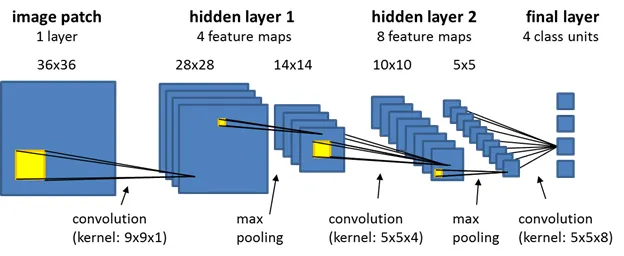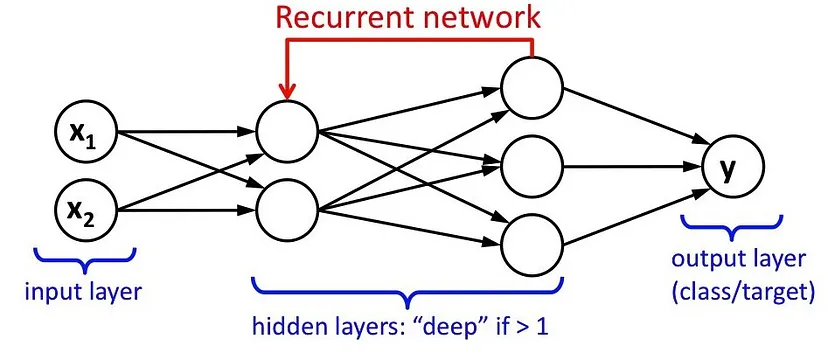
BLOG · 14/9/2023
NEURAL NETWORKS
| OP |

This Article is yet to be approved by a Coordinator.

BLOG · 14/9/2023
| OP |

 \n\n\n##### Convolutional neural networks (CNNs):\nThey are a type of neural network that is specifically designed for image processing. Instead of connecting each unit to all the units in the previous and next layers, a CNN uses filters or kernels that slide over small regions of the input data and produce a feature map. CNNs are commonly used for tasks such as image classification and object detection.\nA CNN can have multiple convolutional layers, each with different filters and feature maps, followed by pooling layers that reduce the size and complexity of the data, and fully connected layers that perform the final classification or regression.\n
\n\n\n##### Convolutional neural networks (CNNs):\nThey are a type of neural network that is specifically designed for image processing. Instead of connecting each unit to all the units in the previous and next layers, a CNN uses filters or kernels that slide over small regions of the input data and produce a feature map. CNNs are commonly used for tasks such as image classification and object detection.\nA CNN can have multiple convolutional layers, each with different filters and feature maps, followed by pooling layers that reduce the size and complexity of the data, and fully connected layers that perform the final classification or regression.\n \n \n\n##### Recurrent neural networks (RNNs): \nThis is a type of neural network that is designed for processing sequential data, such as text, speech, or time series. Unlike other types of neural networks, an RNN has a memory that stores the information from previous inputs and uses it to influence the current output. RNNs are commonly used for tasks such as speech recognition and natural language processing.\n \n\n\nNeural networks are based on the theory of backpropagation. Backpropagation is an algorithm that is used to train neural networks. It works by adjusting the weights of the neurons in the network so that the network can make accurate predictions.\n
\n \n\n##### Recurrent neural networks (RNNs): \nThis is a type of neural network that is designed for processing sequential data, such as text, speech, or time series. Unlike other types of neural networks, an RNN has a memory that stores the information from previous inputs and uses it to influence the current output. RNNs are commonly used for tasks such as speech recognition and natural language processing.\n \n\n\nNeural networks are based on the theory of backpropagation. Backpropagation is an algorithm that is used to train neural networks. It works by adjusting the weights of the neurons in the network so that the network can make accurate predictions.\n \nThe basic idea is to start with a random set of weights for the neurons. Then, the network is presented with a set of training data. The network makes predictions for the data, and the errors in the predictions are calculated. The weights of the neurons are then adjusted so that the errors are reduced. This process is repeated until the network converges, meaning that it makes accurate predictions for the training data.\n\nTo implement these types of neural networks, we can use various libraries and frameworks that provide ready-made functions and classes. For example, in Python, we can use TensorFlow or PyTorch, which are popular and powerful tools for building and training neural networks. \n\n##### Conclusion\nNeural networks are a powerful tool for machine learning. They can be used to solve a wide variety of problems, and they are constantly being improved.\nAs you dive deeper into this fascinating field, you'll discover endless possibilities for using neural networks to tackle real-world challenges.\n"
\nThe basic idea is to start with a random set of weights for the neurons. Then, the network is presented with a set of training data. The network makes predictions for the data, and the errors in the predictions are calculated. The weights of the neurons are then adjusted so that the errors are reduced. This process is repeated until the network converges, meaning that it makes accurate predictions for the training data.\n\nTo implement these types of neural networks, we can use various libraries and frameworks that provide ready-made functions and classes. For example, in Python, we can use TensorFlow or PyTorch, which are popular and powerful tools for building and training neural networks. \n\n##### Conclusion\nNeural networks are a powerful tool for machine learning. They can be used to solve a wide variety of problems, and they are constantly being improved.\nAs you dive deeper into this fascinating field, you'll discover endless possibilities for using neural networks to tackle real-world challenges.\n"